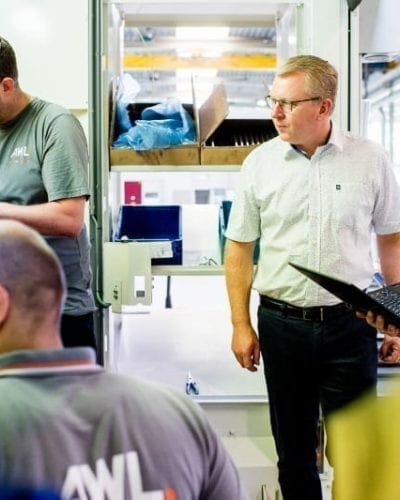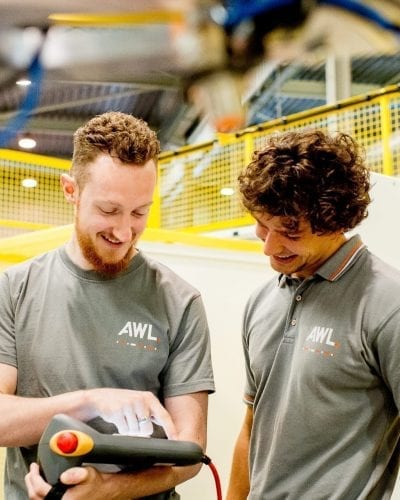Behind the scenes ...
… at the ABB Striebel & John project
One of the most recent projects in which WEMO and AWL collaborated together was the project for ABB Striebel & John (S&J). We asked Jules van Hooijdonk (Project Leader at WEMO), Harold van Pinxteren (Project Manager at WEMO) and René van de Meeberg (Project Manager at AWL) about their experiencees with the project and what the strength is of this merge between two excellent Dutch machine builders.
Reading time: 8 minutes
What is the end product?
S&J is a leading manufacturer of Power Distribution systems. They produce, among other things, (switching) cabinets, among other products, for house building. In the Netherlands, we make particular use of wooden meter cabinets, whereas in Germany, the meter cabinets are of steel, and they are often in the hallway or the basement. The customer wanted to fully automate the production of the housing of these cabinets from coil to finished product, in different sizes.
What was the customer’s requirement?
The cabinets were already being produced partly automated, but this still involved a large amount of manual work. Also, the existing line was due for replacement. The Research & Development (R&D) department of S&J was also working on optimizing existing products and developing new types. To reduce costs, they had to automate further and substantially increase capacity. This involved substantial up-front investments, which had to be approved internally first.

What considerations have been made for a suitable solution for S&J?
A high degree of automation was the basis, combined with very little available floor space and strict requirements for cycle and changeover times. In addition there were several tight deadlines to be met during the delivery process. The new products had to be introduced at the trade fair, and the existing line had to be demolished during the Christmas holidays to make way for the new line.
The original request was based on MAG welding. The use of MAG welding often required finishing and grinding, which laser welding does not. This ensures a much faster production process and therefore, lower costs per product.
René: “In the past, as a result of the welding process, the cabinets were not sufficiently sealed. A great deal of the rework had to be done by hand afterwards. Because we came up with a laser welding solution, S&J could increase production speed and eliminate the manual finishing, grinding, and sealing, such as grinding, and sealing. Ultimately, this saved a significant amount of costs.”
Jules: “Laser welding gives an extremely neat weld that does not require rework. After cleaning, the component can be painted immediately. Laser welding does set stringend requirements for the starting material. To use laser welding as a technique, the welding gap between the different parts has to be constant and very small. Therefore, the bending and punching of the sheet metal must be extremely accurate. That was the biggest challenge for WEMO!”
To make laser welding a succes, the customer must allow room for input in product optimizations at the front end of a project. S&J gave us this opportunity. Together with the departments Production, Engineering, and R&D departments of S&J, WEMO and AWL provided input for a total solution; this was a tremendously valuable collaboration for all parties.

One plus one equals three
René: “We wanted to help the customer to take the automation step a step towards automation. As an experienced machine builder, we can help customers and complement their product knowledge with our automation automated solutions. By doing this together and joining forces from beginning to end, it is not just collaboration, but more a partnership.”
Harold: ‘’We gave the customer our confidence that we were doing everything we could to get to this point, and we received that same confidence in return.’’
Together with S&J, the machine builders looked at the new products’ requirements and were allowed to implement several changes in the product design. The dimensions and tolerances were ultimately adjusted in the product drawings to meet all customer requirements and can still be produced made quickly, reliably, and accurately. The result was that, based on the WEMO solution, four cabinet components with a perfect fit could be transferred to AWL so that they could further process them fully automated. The solution offered by WEMO and AWL was of great added value to the customer. This has been achieved by thinking differently and by pooling knowledge and skills. We could only achieve this by thinking outside the box and combining our knowledge and skills.
Jules: “We achieved the accuracy through the positioning-method, where we repeatedly used the same reference. Doing so, the inaccuracies (tolerances) were not accumulated and tolerance build-up was prevented. Finally, we perfected the punching tools to an optimal shape for the final end product through practical testing.’’
René: “Together, we looked at the product design and adjusted the concept accordingly. If you can have the opportunity to discuss the product design with the customer beforehand, one plus one is three. This benefits the quality of the end product.”
Harold: “The opportunity to provide input in the customer’s product to allow the design of the best possible production line is tremendously valuable for S&J, and that’s what we do it all for.”
What was the biggest challenge in the project?
That was The product design, the diversity of products and materials on just one line and speed. In addition, the deadlines were challenging; a production line had to be delivered although the specifications were not yet defined. The final product design had to be determined before we could proceed with the delivery of the line. The products of S&J had to meet strict standards and requirements, for instance, fire and water testing, and the product had to be visually appealing.
Harold: “We were constantly dependent on the approval of the R&D department of S&J, but also of AWL regarding the weldability. This required very tight and close cooperation.”
The Coronavirus brought an unexpected dimension to the project. Thanks to the new production line of S&J, they were still able to deliver (switching) cabinets in these times, whereas other companies were unable to do so. As a result, they received many orders and they had to scale up in notime.
René: “When the Coronavirus erupted, the production line was not yet completed. Eventually, we adopted a flexible attitude, and ensured that the production line was up and running earlier. It also required us thinking differently, which is why we implemented a HoloLens which allow us to see on-site with the customer. No one could have foreseen the impact of the virus, and it certainly was not an ideal scenario. Thanks to proper mutual coordination, we brought it to a successful conclusion.”
Thanks to the flexibility of all parties, S&J could accelerate production and respond to market needs. Together we have made every effort to realize this for the customer.


What is the strength of the collaboration between WEMO and AWL?
By forming a unified entity at an early stage, you can harmonize processes properly. We are dependent upon one another. AWL needs a good product, and WEMO needs to know the specific product requirements. It is a constant balancing act between the customer’s demands, the requirements of AWL, and the capabilities of WEMO. This is essential in order to achieve the best solution. Knowing what is essential to get the optimal result for the customer. Then It is very valuable that we have already successfully worked together successfully before.
René: “At an early stage, you have to match the right people of AWL with the right people of WEMO. We both have in-house specialists who speak the same language. If they talk to each other, a lot is possible and it creates magic.”
Harold: “I know that S&J expected that two Dutch machine builders could work closely together. During the project, quick, direct communication prevailed and there was a highly professional and solution-oriented way of working. We also were not afraid to include the customer in our discussions. This ensured that we never chose the easiest option for one of the parties, but we always continued to fight for the best solution for all parties. It was not always easy, but in the end, the expectation of the customer came true.”
Looking back on the S&J project. What are you most proud of?
René: “S&J has a future-proof solution. With this automated solution, they can continue to produce in the coming years.”
Jules: “It was an ongoing process together with the customer, WEMO and AWL. You only succeed in this if you participate together, with full confidence, very open-minded and solution-oriented, and then you see how far you can get.”
Harold: “What I found so cool was the request to work with the R&D and Production Departments of the customer and AWL to optimizing a product range to make it suitable for fully automated production. In addition to having the opportunity to provide the production facilities with an incredibly competitive project planning. We overcame the impossibilities of the production line one by one and delivered a machine within the set deadline.”
